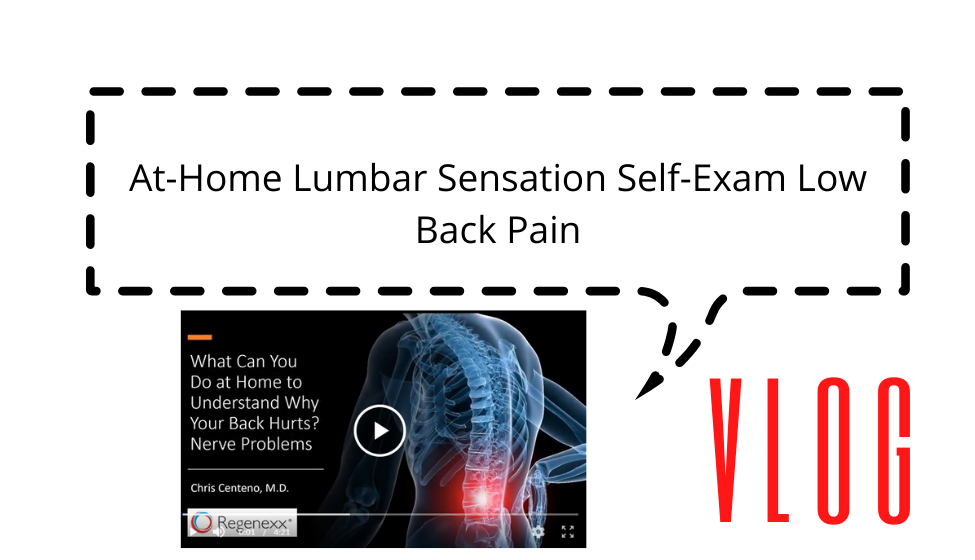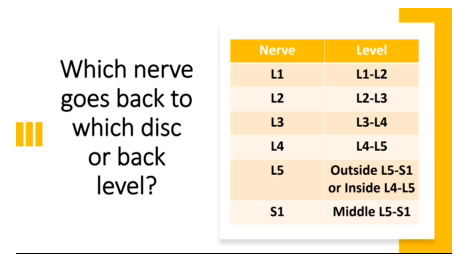Transcript
Hi, It’s Dr. Centeno. And this is part of a bigger series on what you can do at home to understand why your back hurts.
And today we’re going to focus on nerve problems.
So, if you’re stuck at home, what can you do to figure out what’s going on with your back? Healthcare has always been a situation of asymmetrical knowledge – right? The doctor knows more than the patient. My goal with this is to give you the power to figure out what’s wrong. So, I’m going to share my physical exam secrets learned over a lifetime of treating patients with pain.
So, realize that understanding what’s going on with your back nerves is actually many times more powerful than an MRI. For instance, I’ll often see an MRI that looks like it should be, let’s say L5-S1 towards the bottom of the low back. But when I do the exam, it looks like L-3 and I can tell you that I will get better results if I treat L-3 than L5-S1.
So, each nerve in your back comes out near its disc. In each bone in the back is numbered L-1 to S1, as shown as are the nerves numbered. And to test nerves in your back, you’ll need a pin or a safety pin and just your finger.
NEEDED:
So, we’re going to do sensory testing of the lower leg. So, with your finger, I want you to test each of these areas. Side by side. So, for L5 it’s the big toe on the right versus the big toe on the left.
Just like that. And once you do the same thing with the pin, gently poke yourself a couple times on both your big toe on the right, your big toe and the left. And again, you’re going do these three areas here. You’re going to do the L4 area. You’re going to do the L5 area. So, the L4 is the inside of the leg. The L5 is the big toe. And you’re also going to do that S1 area which is the outside of the foot.
So, once you test all three of those areas side to side and write down what you feel.
Now, you’re going to do the same thing in the upper lumbar spine, and that’s going to be L-1 at the groin, L2 at the inside thigh and L-3 at the mid-thigh, again, side to side.
You can brush your finger on the area to check for sensation. Again, poke yourself a couple of times, check it left and right. And what you’re trying to see is,
- Does one side feel more than the other?
- Or less than the other?
- Or do they feel identical?
If you have less or more sensation in one of these nerves, what does that mean?
Well, it means that nerve is having problems, and that’s localising where your issue is in your back. And that can be caused by disc bulges, or herniated discs, or arthritis pressing on nerves. And, now, I’m going to show you which nerves relate back to which areas…
So, if you look at this (above), if you, for instance, were having problems at the L1 nerve that goes back to the L1-L2 level. For the L5 nerve, it can be either the outside of the disc at L5-S1 or the inside of the disc at L4/L5. And again, S1, that’s usually the middle of the disc at L5-S1.
So now you’ve got a table and you can look at your nerves and see which levels are having problems. Now you’ve got the power to walk into your doctor’s office and say, “You know what, I’ve got an L5 nerve problem; I figured that out myself.”
And that means that we need to be looking at L4, L5 or S1 or I’ve got an L2 problem, and that’s L2-L3.
So, if you want to learn more schedule, visit with a Regenexx provider or read about the Perc-FSU. But my goal here is to give you the power to do your own self-exam at home. Thanks so much for watching and have a great day!






